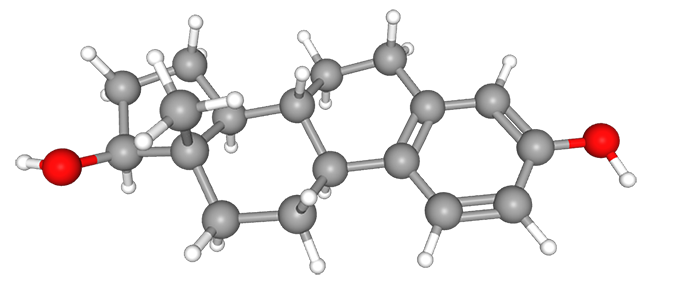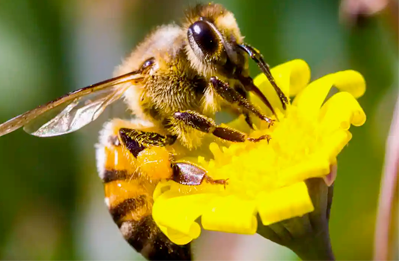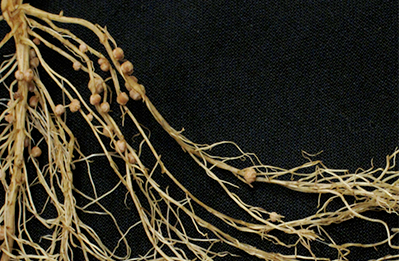| Endocrine Disruption |
Endocrine Disrupting Chemicals
Signaling to Communicate
But, a loud noise or being far apart can interfere with the signal and possibly disrupt the communication. If that happens, the received message could be normal, garbled, or not gotten at all, leading to either no reply or an altered response, such as “What?” CAPTION: Plants use colorful,
scented flowers as signals to attract pollinators like this bee.
CREDIT: The Guardian Endocrine Disrupters
Compounds that interfere with natural hormone functions have
many names: environmental estrogens, xenoestrogens, endocrine disrupters,
endocrine modulators, and environmental hormones, to name the most common.
Although all researchers do not accept one specific term, endocrine disrupters
(EDs) and endocrine disrupting chemicals (EDCs) are probably used widely. Altered States Normally, hormones released from glands signal target cells to start and stop complex chemical relays that control development, reproduction, and internal functions. The foreign EDs, though, can interfere in a number of ways and send unintended messages. Like the loud noise or distance that disrupted our hello message, EDs can mess with and possibly alter biological signals. They can do this in several ways. EDs can bind to hormone receptors where they can mimic, block, or otherwise influence normal hormone actions. The altered signal can cause proper or improper responses with similar, none, weaker, stronger, or totally different effects than natural hormones. Substances can also act indirectly by altering how natural hormones, their receptors, or their protein carriers are made, used, and broken apart. But, a chemical may have more than
one action. Some interlopers may interfere in only one way; others can interact
in multiple ways. For example, p,p’-DDE, a derivative of the pesticide
DDT, can weakly mimic estrogen and block out androgens, producing an overall
feminizing effect. An Incomplete Story
Lesser known, but just as important, are substances that interfere with thyroid and androgen hormones. Antiandrogens, like the fungicide vinclozolin, produce males with malformed organs and female characteristics. Opposite effects are seen in fish exposed to the growth steroid trenbolone and plant steroid compounds found in pulp and paper mill effluent. Both masculanize, producing females with male attributes. But, other hormone signals and body systems, such as the peptide hormones, may also be vulnerable. These less studied interactions influence most body regulatory processes, including appetite, immunity, brain functions, and metabolism. Physical factors, such as low oxygen conditions, can influence hormones, too. Light and electromagnetic fields may contribute to certain cancers by altering performance of the hormone melatonin, which controls human hormone production and sleep (Blask et al. 2005). EDCs can also interrupt signaling between organisms, but again, effects are not fully understood. Legume plants, such as beans and soybeans, rely on special bacteria living in their roots to provide needed nitrogen. To recruit the bacteria to their roots, plants release chemicals into the soil that can bind to the bacteria’s receptors and initiate the gene expression necessary to find its way to the plant. Chemicals, such as DDT and the herbicide 2,4-D, can block signaling to various degrees, hampering recruitment of the essential partners (Fox 2004; Fox et al. 2004). Although most are weaker than natural hormones, some EDCs have been associated with reproductive and developmental problems in wildlife and laboratory animals. Many of the indicted chemicals have distinct effects in different species and organs and at different developmental stages. Quantity, potency, mixes, and inappropriate timing, such as exposure to developing fetuses, growing infants, and young children whose rapidly growing bodies depend on endocrine signals, are important factors that dictate the type and degree of known effects, including cancer, deformities, and reproductive problems. click here to read more about human effects... Because they are everywhere, wildlife and humans face a constant barrage of toxic chemicals. Air, water, dust, and animals carry EDCs to every continent. Exposure occurs in every stage of life, from development in egg or womb to adulthood, and any number of sources, including food, air, water, soil, household products, breast milk, and the womb. How much is too much? We still do not know. Although EDCs can affect wildlife, the human health risks that may be associated with these mostly low-level yet constant exposures are still largely unknown and highly controversial. back to topHow we got here  The idea that naturally occurring chemicals can alter
hormone function and affect health is an old one. Human cultures from antiquity
to the present sought remedies and drugs from plants they knew had the power to
heal or hurt. Some of these plants, such as mold, clover, fruits, and legumes
(soy), contain estrogen-like chemicals. The mimics can cause infertility and
other reproductive problems as well as impede or encourage disease in domestic
animals and humans. The idea that naturally occurring chemicals can alter
hormone function and affect health is an old one. Human cultures from antiquity
to the present sought remedies and drugs from plants they knew had the power to
heal or hurt. Some of these plants, such as mold, clover, fruits, and legumes
(soy), contain estrogen-like chemicals. The mimics can cause infertility and
other reproductive problems as well as impede or encourage disease in domestic
animals and humans. CAPTION: The most common vertebrate estrogen is 17-beta-estradiol. (click image for PubChem Compound Summary). CREDIT: PubChem, National Library of Medicine
A newer notion is that certain synthetic chemicals can also interact with chemical messaging systems, whether or not they were made for that purpose. Some not meant to be endocrine active were later found to act like hormones. For example, a 1938 study verified that the synthetic bisphenol A, synthesized decades earlier, could mimic estrogens (Dodds and Lawson 1936, 1938). Others were always intended to exploit natural systems. For instance, drugs in birth control pills simulate natural estrogens and progestins. Many pesticides developed to kill insects, weeds and other pests intentionally target hormone, immune, and other essential signaling systems. For this reason, it should not be surprising that certain toxic compounds can also affect the systems in wildlife and humans. In the United States, production and use of synthetic organic chemicals began in earnest in the 1940s World War II era and climbed steadily throughout the second half of the century. Production topped more than 400 billion pounds annually in the late 1990s. Today, compounds used as pesticides, drugs, food and product additives, and industrial chemicals (solvents, lubricants) number more than 80,000. By the early 1960s, concern was already growing about the rapid and unrestricted use of chemicals. The synthetic compounds, especially the insecticide DDT, were contaminating water, soil, wildlife, and even humans possibly causing severe health problems (egg shell thinning, cancer, die offs) in wildlife, asserted Rachel Carson in her book Silent Spring. The problems were especially pronounced in top-of-the-food-chain predatory species that eat other contaminated animals and concentrate the chemicals. Although it was not yet clear that many of the substances were hormonally active, evidence gradually accumulated. For one, Australian farmers reported infertility, reproductive abnormalities, and even death in sheep grazing on clover and cows eating moldy feed. Estrogen-like compounds (phytoestrogens) were to blame. click here to read more about phytoestrogens...
click here to read more about wildlife effects... By the 1990s, evidence for the underlying, unifying theme of endocrine disruption was growing. And word about it was getting out. A cadre of scientists, brought together by researcher Theo Colborn, gathered in Racine, Wisconsin, for the first Wingspread conference in 1991. The result was a unified consensus statement asserting that synthetic chemicals could interfere with hormones of animals, and possibly people. Fetuses and the young were at the greatest risk for disease, abnormalities, and reproductive problems that were already manifesting in wildlife (Wingspread Statement 1991). Then, books (Our Stolen Future, Hormonal Chaos), Web sites (e.hormone), government reports, and more consensus statements from workshops and conferences roused political and public interest (Colborn et al. 1996; Krimsky 2002). In response, governments convened expert panels to investigate risks from EDs and develop testing and screening programs (EDSTAC 1998). The sheer magnitude of the job, though, is daunting and most have made little progress towards testing the compounds. click here to read more about what it means... Several hormonally active chemicals have been restricted since Rachel Carson’s first warnings. For instance, by the 1980s, the US and Europe had banned or reduced use of many of the most persistent chemicals, such as the insecticide DDT and the industrial PCBs. But, the chemicals’ widespread presence and long-lasting effects linger today because the persistent organic pollutants (POPs) degrade slowly, accumulate in fat, and are still produced and used in some parts of the world. The Stockholm Convention, signed by a majority of world countries and ratified in 2002, is an effort to control what’s considered the worst of the worst (Stockholm Convention on POPs Web site). Less long-lived chemicals with endocrine disrupting potential infiltrate a vast array of everyday products. Many occur at low levels in products we all use. Bisphenol A is added to plastic water bottles, food can linings, and dental sealants. The ubiquitous phthalates keep plastics in baby toys and medical devices soft and flexible and are added to an enormous number of products including cosmetics, drugs, pesticides, and paints. Polybrominated diphenyl ethers (PBDEs) retard fire and are widely used in foams and plastics. Europe has successfully limited use of certain phthalates and PBDEs and California is trying to do the same. However, not everyone agrees that vast numbers of synthetic chemicals - some banned, others still widely made and used - pose long-term reproductive, developmental, and other health effects in wildlife and humans. Even one of the most comprehensive reports to date, the 2003 global assessment of endocrine disruptors, called for more research after finding health effects in wildlife exposed to high amounts but less clear evidence for human health effects (IPCS 2002). back to topReferences
back to top |
 I say hello. You say hi back.
We’ve just used word signals to communicate. In this simple example, a sender
(me) sends a verbal message or signal (hello) that conveys information to a
receiver (you), who responds back to the signal with another signal (hi).
I say hello. You say hi back.
We’ve just used word signals to communicate. In this simple example, a sender
(me) sends a verbal message or signal (hello) that conveys information to a
receiver (you), who responds back to the signal with another signal (hi).  A bevy of synthetic chemicals and
natural plant compounds, as well as some physical factors, such as light and
low oxygen, can also interact with these natural chemical-signaling systems.
The endocrine system, with its complex network of glands, hormones, and cell
receptors, is especially prone to their influences.
A bevy of synthetic chemicals and
natural plant compounds, as well as some physical factors, such as light and
low oxygen, can also interact with these natural chemical-signaling systems.
The endocrine system, with its complex network of glands, hormones, and cell
receptors, is especially prone to their influences. To date, most is known about how
EDs interfere with one or a combination of steroid hormones (the estrogens, androgens, progestins, and corticoids) and
thyroid hormones, including thyroxine. Within this group, attention has focused
on the so-called environmental estrogens – the synthetic and plant
compounds that affect the natural estrogen hormones, particularly the potent
and widespread estradiol, which regulates reproduction. A wide range of
invertebrates (coral, lobster, snails, and starfish) and all the vertebrates
produce estradiol (Cheek et al. 1998). Altering this hormone could affect a
large section of the Earth’s organisms.
To date, most is known about how
EDs interfere with one or a combination of steroid hormones (the estrogens, androgens, progestins, and corticoids) and
thyroid hormones, including thyroxine. Within this group, attention has focused
on the so-called environmental estrogens – the synthetic and plant
compounds that affect the natural estrogen hormones, particularly the potent
and widespread estradiol, which regulates reproduction. A wide range of
invertebrates (coral, lobster, snails, and starfish) and all the vertebrates
produce estradiol (Cheek et al. 1998). Altering this hormone could affect a
large section of the Earth’s organisms.  For another, similar reproductive problems were recognized
in wildlife, laboratory animals, and humans during the following three decades.
Eggshell thinning in eagles and sea gull breeding troubles, which both
contributed to plummeting bird populations in the Great Lakes region, were
linked to feminizing effects from DDT exposure.
For another, similar reproductive problems were recognized
in wildlife, laboratory animals, and humans during the following three decades.
Eggshell thinning in eagles and sea gull breeding troubles, which both
contributed to plummeting bird populations in the Great Lakes region, were
linked to feminizing effects from DDT exposure.